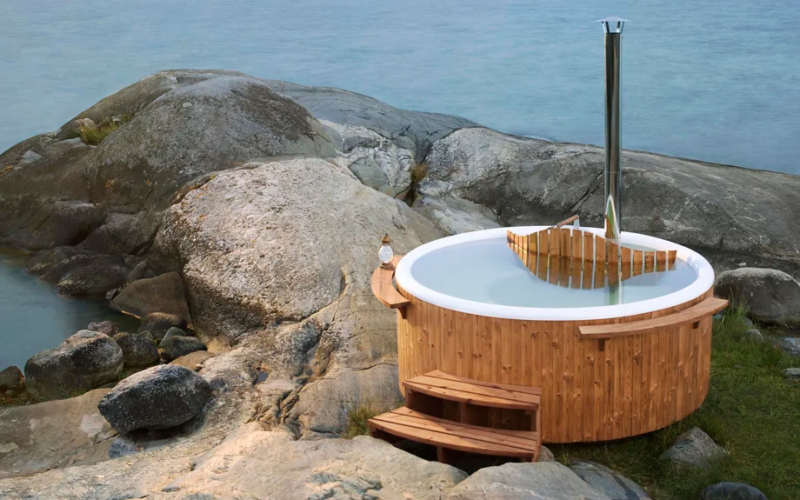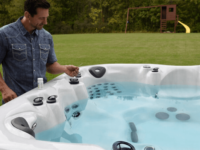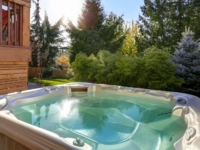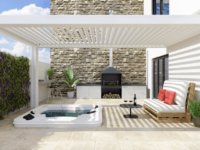A wood-fired hot tub is a great option for those who want to furnish their area around the house more luxuriously, and for those who wish to relax any time they want with a high level of comfort. Just imagine how nice it is to take a warm hot tub outside in the fresh air, under the sounds of nature and the bright smell of wood.
Sounds very appealing, doesn’t it? Let’s dig a little deeper to see if everything is so fabulous in fact. There are some benefits of wood-fired hot tubs which we’ll describe further. Also, you will learn how a wood-fired hot tub works and how it differs from an electric hard shell hot tub. However, if you are a fan of inflatable hot tubs, you can check out the top 5 models of them in our other article.
Must-Know Features Before Hot Tub Purchasing
Before you buy a wood-fired hot tub, you need to research and consider certain factors. We’ve had several people on our team own these hot tubs, so we’ve questioned them about all the nuances and are ready to share them with you.
- The presence of an internal or external heating element
If a wood-fired hot tub has an internal heater, also called a furnace, it takes up some space. Thus, it cuts down considerably on seating space, and firewood will need to be taken in through the port at the top of the hot tub.
The outside heater is outside the wood-fired hot tub, mostly closer to the bottom. This heater takes longer to heat the water inside the hot tub but does not take up unnecessary space inside the device.
- Size of the wood-fired hot tub
For ease of understanding the size of the device, many manufacturers indicate the characteristics of its capacity by the number of people. For example, a certain hot tub has a capacity of 4 people, which means it can hold 4 adults at a time. Some wood-fired hot tubs can hold 2 people, while others have a capacity of up to 8 people.
- Depth of the wood-fired hot tub
These hot tubs themselves are much deeper than hard shell hot tubs. This affects not only the feeling of relaxation but also the degree of a positive effect of the hot tub on the human body. If you want a more detailed workout of the muscles and joints throughout the body, we recommend choosing a deeper wood-fired hot tub. It is important to note that the depth of the hot tub is not related to its size and capacity.
- Possibility of finding/purchasing and storing firewood
As you know, this kind of hot tub doesn’t need electricity to operate. It uses a completely different source of energy, namely firewood. And it is necessary to have this to use a wood-fired hot tub. In some areas, you can just get firewood for free by collecting it yourself and in some areas, it is necessary to purchase them.
If you cannot find/purchase this natural resource, then you should not choose such a hot tub. Unfortunately, at the moment there are no alternatives to wood for a wood-fired hot tub, such as wires.
- Features of installing a wood-fired hot tub
There are many different models of this device from different manufacturers. They have certain similarities, as well as differences between them. One of them includes the installation of a hot tub.
The main differences in installing a wood-fired hot tub are as follows: its size, its assembly from the manufacturer, the space required for installation, and whether you need to additionally purchase tools and accessories for installation. Always check the installation instructions provided by the manufacturer to find out if they are clear to you.
How Do Wood-Fired Hot Tubs Work?
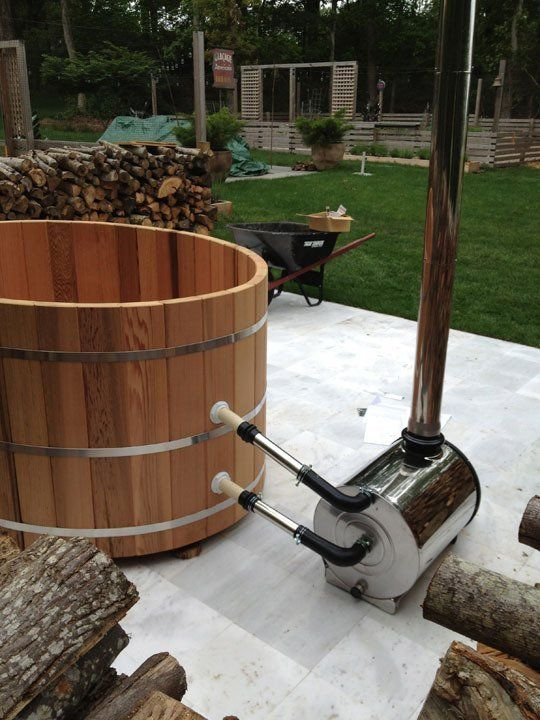
The basic principle of a wood-fired hot tub is to use only environmentally friendly elements. It doesn’t require electricity to operate like conventional hard-shell hot tubs, but more on that later.
Since the hot tub works by heating with wood rather than electricity, it heats up well and keeps warm. Temperatures in such a hot tub can reach 104-105°F.
The difference in using a wood-fired hot tub can also be an internal or external furnace (heating element). As we described above, the indoor furnace heats hot tub water faster but takes up more space inside. The external furnace, on the other hand, does not take up seat space in the hot tub but heats the water twice as slowly.
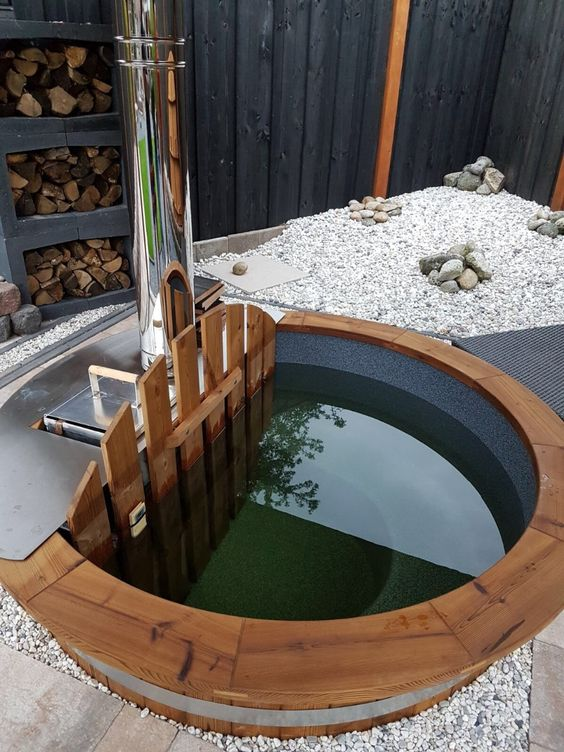
The internal furnace is separated from the main part of the hot tub for recreation with a wooden fence, ensuring the safety of users of the device. Because the heat released from the furnace is directed just into the water, it heats up faster than from the external furnace.
The internal heater of the wood-fired hot tub is made of marine aluminum, which is a strong material that resists corrosion. It is equipped with a special pipe located above the water level, the oven doors, and equipped with a chimney. The pipe is needed to remove the smoke evaporating from the combustion process of firewood to the outside.
The lid of the stove to put firewood in it is above the water level and also behind a special wooden fence, as well as the stove itself. Since it is not separate from the hot tub, you do not need to get out of the hot tub to put the wood to keep the water warm.
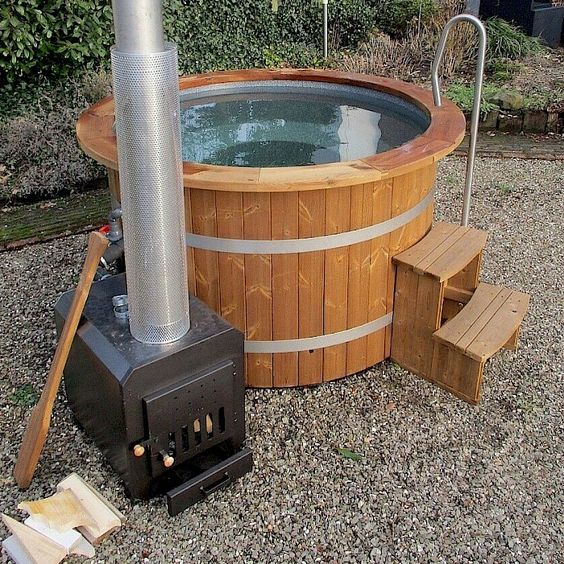
The technology for heating hot tub water with an external heating element is called a thermosiphon. The external heater slab is located outside the wood-fired hot tub and is connected by two pipes:
- One takes the cold water from the hot tub to heat it;
- The other conveys heated water to the hot tub.
So, to use a hot tub with an external heater, you will need to draw water in the hot tub and draw and fire the wood on the stove. This water will be drawn from the hot tub through one pipe, and through the second pipe, it will be fed back already heated.
This technology is more convenient for controlling the temperature in the hot tub, although it does require more wood and time to heat. Based on the fact that the water needs to circulate through the pipes to heat it, you need to be careful when using the hot tub in the cold. This is because the water in the pipes can freeze.
Wood Fired Hot Tubs’ Pros & Cons
Modern times offer a wide variety of hot tubs, among which it is impossible not to mention the wood-fired ones. So what are its advantages and disadvantages?
Pros
- High heating speed (on average, 5 times faster than an electric hot tub);
- Environmentally friendly option;
- Very aesthetic appearance;
- Great to help to relax;
- Deeper than an electric hot tub;
- Doesn’t waste electricity.
Cons
- You should be able to purchase or find firewood;
- Water must be drained and refilled with each use.
Wood-Fired vs. Electric Hard Shell Hot Tubs
There are many different hot tubs, which can be divided into electric hard shell ones and wood-fired. What are the differences between them, and which is better to buy? Let’s look into it.
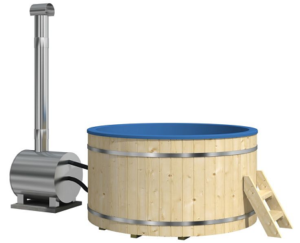 | 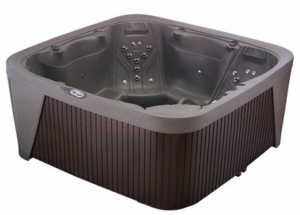 | |
How Long Does It Take To Heat A Wood-Fired Hot Tub?
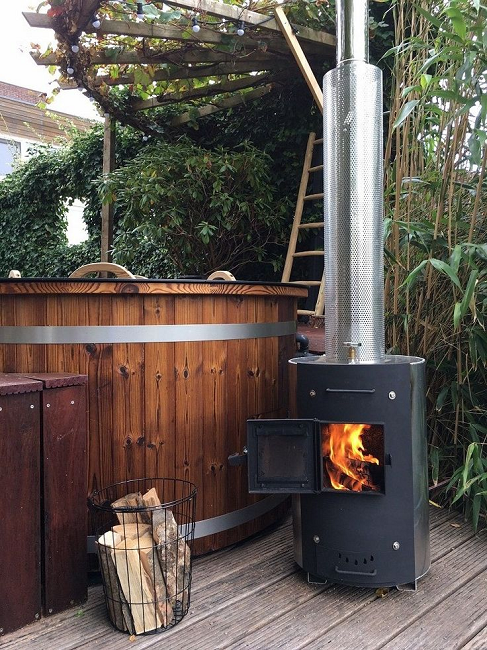
The heating time directly depends on which heater is used to operate the wood-fired hot tubs. As we know, they have two types of heaters – external and internal.
- The external heater is located outside the oven. However, it is located low and close enough to transfer heat to the water.
- The internal heater is right in the water. The wood is put into it through the hole at the top. Because of its location, it heats the water faster.
The choice of the heater depends on your preference. Despite its efficiency, the internal one takes up space inside the wood-fired hot tub. Such hot tubs with an indoor furnace heat water faster. External, on the contrary, does not take space inside, so the hot tub can accommodate more people, but it will heat up more slowly.
Also, the heating rate affects the wood quality and the hot tub capacity. Among the favorites are oak, birch, ash, and acacia. They burn long enough and have a high heat output. As for the capacity, the small hot tub (up to 400 gallons) will heat up faster than a large one.
And so, let’s find out how long it will take for your wood-fired hot tub to heat up. Let it be a 350 gallons 2-person hot tub with oak as wood. Then it will take about 2.5 hours to reach 104°F. If you heat a hot tub with 2 to 3 times the capacity, it will take about 3 times as long.
Summary
Wood-fired hot tubs are tubs in which the water is heated by a stove, where the fuel is wood. They are most often round in shape because their design is inspired by the Japanese and they are predominantly made of cedar. This wood is very resistant to rot.
Wooden wood-fired hot tubs heat water faster than electric ones, and their simple and concise design will decorate your home or lawn. It is a great choice for both 2 people and a large company. However, when considering such devices, many questions may arise, one of which is “How do they work?”.
So, in this article, we covered how wood-fired hot tubs work, pointed out the pros and cons of these hot tubs, compared wood-fired and electric spas, and wrote how long it takes you to heat water to answer all your possible questions.
FAQ
📌 How do wood-fired hot tubs work?
Wood-fired hot tubs heat water by an internal or external furnace that burns wood and transfers the heat to the water.
🌡 How long does it take to heat water in hot tubs with wood?
It takes about 2.5 hours to heat 350 gallons of water to 104°F in a 2-person wood-fired hot tub.
🛀 Which hot tub heats faster: electric or wood-fired?
A wood-fired hot tub heats water to 104°F in 2.5 hours, and an electric one in 8, which is 3.2 times faster.
💸 What do I need to know before purchasing the wood-fired hot tub?
Before purchasing the wood-fired hot tub you need to check the presence of an internal or external heating element, define its size and depth, check if there is the possibility to purchase & store the firewood and find out what are the features of the hot tub’s installation.
✅ What are the benefits of wood-fired hot tubs?
The benefits of wood-fired hot tubs are heating rate (2.5 hours), environmentally friendly materials, aesthetic appearance, depth, saving electricity, and no extra chemicals for caring are needed.
